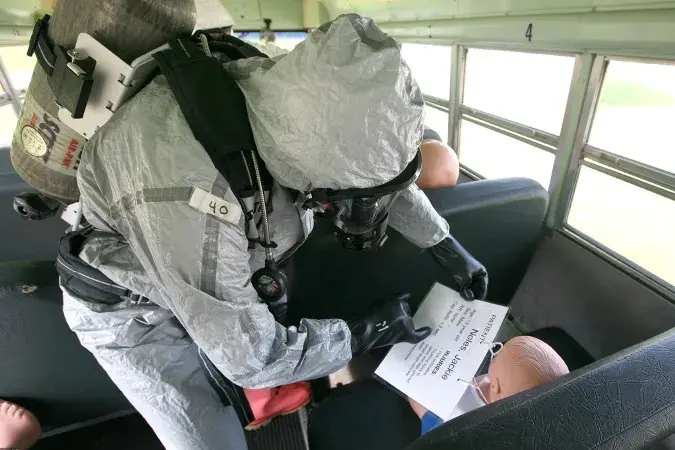Emergency workers face many risks and challenges when disasters arise. To address these dangers, the National Institute for Occupational Safety and Health (NIOSH) developed the Emergency Responder Health Monitoring and Surveillance [Link no longer valid, http://www.cdc.gov/niosh/topics/erhms/] (ERHMS) system, a health monitoring and surveillance framework that includes recommendations and tools specific to protect emergency responders during all phases of a response. NIOSH worked with the U.S. National Response Team and a number of federal agencies, state health departments, labor unions and volunteer emergency responder groups to develop ERHMS guidelines.
 A plan for monitoring emergency responder health and safety is an important part of providing protection.
A plan for monitoring emergency responder health and safety is an important part of providing protection.
The goals of the ERHMS are to:
- Identify exposures, signs and symptoms early in the course of an emergency response;
- Prevent or mitigate adverse physical and psychological outcomes;
- Ensure workers maintain their ability to respond effectively and are not harmed during response work;
- Evaluate protective measures; and
- Identify responders for medical referral and possible enrollment in a long-term health surveillance program.
ERHMS principles apply to both small- and large-scale events, including local, state and federal level responses. It applies to all who are involved in deployment and protection of emergency responders, including incident managers, response organization leadership, health, safety and medical personnel and emergency responders.
The ERHMS is broken down into three phases: pre-deployment, deployment and post-deployment phases. A basic principle of safety and health in emergency response is to maintain accountability for all emergency responders. In the pre-deployment phase, a roster and credentialing of emergency response and recovery workers is conducted.
This phase includes four functions designed to operate with one another:
- Registration—recording basic and credential information on the responder;
- Emergency credentialing—assigning a credential level based on responder certification and education;
- Re-verification—periodically confirming responder information; and
- Emergency badging—assigning an identification badge in accordance with the credential level.
In the deployment phase, the focus is on-site responder in-processing and establishing a response roster. Whenever the level of response is greater than what the first tier of local responders can handle, a roster is used to log everyone who reports to the disaster site and is engaged in the response or remediation work. For many workers, personal protective equipment will be issued to them during their site-specific training or as they arrive at the response scene and are placed on the response roster. In the post-deployment phase, the focus is on the responder out-processing assessment—the minimum post-deployment evaluation that should be conducted for responders. Out-processing assessments determine whether responders were harmed performing their work duties and to what extent. The assessments also evaluate trends within the population of workers to identify potential risks to others, such as chemical exposures, microbial agents, physical agents, long shifts or stressful experiences.
For a general overview of ERHMS, as well as fact sheets, studies and online training courses, visit http://www.cdc.gov/niosh/topics/erhms [Link no longer valid].
